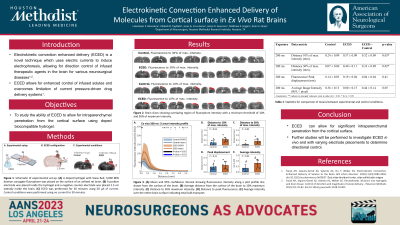Electrokinetic Convection Enhanced Delivery of Molecules from Cortical Surfaces in Ex Vivo Rat Brains
Friday, April 21, 2023


Lokeshwar S. Bhenderu
Medical Student
Houston Methodist
Tomball, Texas, United States
ePoster Presenter(s)
Introduction: Electrokinetic convection enhanced delivery (ECED) is a novel technique which uses electric currents to induce electroosmosis and electrophoresis, allowing for directional control of infused therapeutic agents into the brain for various neurosurgical diseases. ECED allows for enhanced control of infused solutes and overcomes limitations of current pressure-driven drug delivery systems. We studied the ability of ECED to allow for intraparenchymal penetration from the cortical surface using doped biocompatible hydrogel.
Methods: Eighteen rats (F334, male) were sacrificed at 7 weeks old and unfixed brains were harvested. An acrylic acid hydrogel doped with zwitterionic 0.4 mM Texas Red dextran conjugate was placed on the cortical surface of the brain. A positive electrode was placed inside the hydrogel along with a negative intraparenchymal counter electrode. ECED was performed with a 50µA current for 30 minutes while control trials were performed with a 0µA current for 30 minutes. The brains were sliced immediately after ECED and fluorescent microscopy was used to determine cumulative intensity of florescence, indicating total bulk transport, and distance from the surface of the brain to 10% of maximum fluorescence, indicating depth of penetration.
Results: The cumulative intensity over a circular region of interest (radius = 200 µm) was 11.09 (95: CI [6.52, 15.64], P< 0.05) average relative fluorescent units (RFUs) in control and 17.35 RFUs (95: CI [11.69, 23.00], P< 0.05) with ECED. The depth of penetration was 843 µm (95% CI [347.5, 1242.6] µm, P< 0.05) in control and 1601.7 µm (95% CI [1459.2, 2000.5] µm, P< 0.05) with ECED. There is a statistical difference with both cumulative intensity and depth of penetration between control and ECED trials.
Conclusion : We show that ECED can allow for significant intraparenchymal penetration from the cortical surface. Further studies will be performed to study ECED in vivo and with varying electrode placements to determine directional control.
Methods: Eighteen rats (F334, male) were sacrificed at 7 weeks old and unfixed brains were harvested. An acrylic acid hydrogel doped with zwitterionic 0.4 mM Texas Red dextran conjugate was placed on the cortical surface of the brain. A positive electrode was placed inside the hydrogel along with a negative intraparenchymal counter electrode. ECED was performed with a 50µA current for 30 minutes while control trials were performed with a 0µA current for 30 minutes. The brains were sliced immediately after ECED and fluorescent microscopy was used to determine cumulative intensity of florescence, indicating total bulk transport, and distance from the surface of the brain to 10% of maximum fluorescence, indicating depth of penetration.
Results: The cumulative intensity over a circular region of interest (radius = 200 µm) was 11.09 (95: CI [6.52, 15.64], P< 0.05) average relative fluorescent units (RFUs) in control and 17.35 RFUs (95: CI [11.69, 23.00], P< 0.05) with ECED. The depth of penetration was 843 µm (95% CI [347.5, 1242.6] µm, P< 0.05) in control and 1601.7 µm (95% CI [1459.2, 2000.5] µm, P< 0.05) with ECED. There is a statistical difference with both cumulative intensity and depth of penetration between control and ECED trials.
Conclusion : We show that ECED can allow for significant intraparenchymal penetration from the cortical surface. Further studies will be performed to study ECED in vivo and with varying electrode placements to determine directional control.
